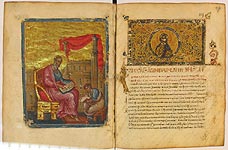Tetraevangelion.
12th century; last quarter of 13th cent. Constantinople (?)
Q (242 ı 183). II+156+II leaves.
Parchment. Ink, colours.
It is written in a minuscule hand.
10 Canon Tables are placed in ornamental frames (fols. 5-9v), 4 full page miniatures (fols. 10v, 76v, 116v, 116v), 4 ornamental head-pieces (fols. 11, 51, 77, 117), one of them contains a miniature (fols. 117), 3 ornamental initials, one historiated initial letter. Headings and small initials are painted in crimson ink.
At the National Library of Russia, two manuscripts, which are now held at shelfmarks: –Õ¡. √˜. 101/1 and –Õ¡. √˜. 101/2, once were parts of the single codex. That codex included all the New Testament texts (except the Apocalypse), supplemented with prefaces, headings and epigrams. At the same time, the manuscript, containing such extinsive contents, was of convenient middle size, and was, very likely, indended for private use. The manuscript, text and artistic decoration of the Four Gospels dates from the 12th century. But, during the restoration of the manuscript in 1968, a special research was being done to establish that portraits of the Evangelist Evangelists had been completely repainted in the last quarter of the 13th century.
The half-length portrait of the blessing Christ occupies the medallion, painted inside the head-piece before the Gospel of John. Such medallions were wide-spread exactly during the 12th century. This original image, like the figure of John the Evangelist contained in the historiated initial (folio 117r), represents the early stage of the creation of the manuscript and does not cover with later paintings.
Until the 40s of the 16th century the manuscript was kept at the Great Lavra of St Athanasius on Mount Athos, then it belonged to Pierre Seguier (1588-1672), Chancellor of France. It devolved on his nephew, Duke de Coislin, and, finally, came into the abbey of St Germain-des-Pres. It passed through hands of Bernard de Montfaucon (1655-1741), who numbered still the single whole codex. At the end of the 18th century P.P. Dubrovsky (1754-1816), serving as the secretary and interpreter with the Russian Embassy at Paris, acquired the manuscript. In 1805 the codex entered the Imperial Public Library with his outstanding collection.
Shelfmark: –Õ¡. √˜. 101/1.





